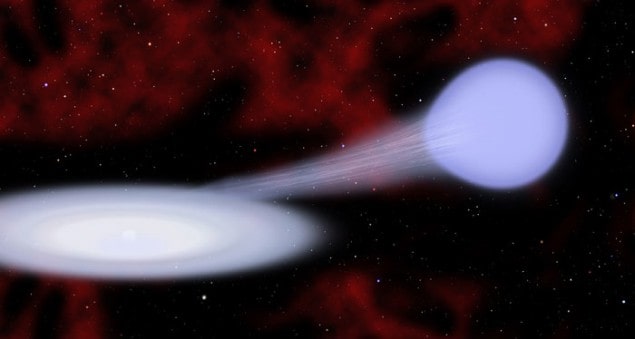
A new type of supernova has been defined by researchers from the US. Designated type Iax, this new class is seen to be less energetic and fainter than previously defined and similar type Ia events – and may even leave behind part of its originating star.
Previously, only two classes of supernovae were recognized – core-collapse events, the explosion of stars 10–100 times as massive as our Sun, and type Ia supernovae, which involve the complete destruction of a white dwarf. Now, a team led by Ryan Foley at the Harvard-Smithsonian Center for Astrophysics has identified 25 members of the new type Iax class based on optical spectroscopic and photometric studies. Its work has shown these stars to be less energetic and with a lower absolute magnitude than would be expected with their type Ia cousin. The team believes that the supernovae of this new class originate from a binary star system comprised of a white dwarf that gathers helium from a companion star, which has lost its outer hydrogen.
Runt of the litter?
“A type Iax supernova is essentially a mini supernova…it’s the runt of the supernova litter,” says Foley. “It turns out that type Iax supernovae are relatively common, but we only recently discovered them because they’re very faint, some only 1% as bright as type Ia supernovae.”
As a result of their absence from elliptical galaxies – which are populated by older stars – it is believed that type Iax supernovae come from young star systems. This observed distribution may be related to the relatively short lifetimes of helium-burning stars, which do not last long enough to be found in elliptical galaxies. The team is uncertain what causes the white dwarf to become a supernova. One theory suggests that the overlying helium shell ignites first, transmitting a shockwave into the white dwarf within, with the opposing hypothesis proposing that the dwarf core might go first, in response to the influence of the surrounding helium.
Chances of survival
In some cases, the researchers believe that the supernovae events might be so weak that the white dwarf may even survive the explosion. “It’s a little uncertain exactly what will happen to the white dwarf,” Foley told physicsworld.com, explaining that such a partial deflagration might be expected to leave the star with a lower mass, but with added energy received from the supernova. “Both of these changes should make the star bigger and hotter,” Foley concludes, “so I expect some sort of puffed up white dwarf.”
Unlike other supernovae, members of the type Iax are too varied and faint to be used as standard candles – objects with a known luminosity and observed brightness that can be used to reveal their distance from Earth. However, the researchers believe that the new class could offer insights into supernovae in general. Not only do these events showcase a previously unknown way for a star to explode – with a slower moving ejecta that is easier to analyse – but their physical similarities to, and differences from, type Ia supernovae enable us to focus our models of this existing class of event.
Careful consideration
“From an observational point of view, the substantial sample of events that resemble SN 2002cx [the prototypical member of the new class] and the estimate that these sort of events happen [a third] as often as classical type Ia supernovae is compelling,” comments Craig Wheeler of the University of Texas at Austin, US, who was not involved in the research. He adds that while the proposed model – of a fully or partial deflagrating white dwarf with a companion helium star – fits well with the observed properties, such models warrant careful consideration before any firm conclusions are reached.
“If this is the appropriate interpretation, then these events come with a promise to teach us more about the nature of thermonuclear explosions,” Wheeler adds. “Elucidating the nature of these events also holds great promise to aid us in better understanding stellar evolution in binary star systems in all its great variety.”
Next, Foley and colleagues are hoping to address the possibility that the white dwarves might, in some cases, survive going supernova. In order to work on this theory, the team simply needs to observe more supernovae, Foley explains, adding the caveat that this kind of observation will only be possible for the closest supernovae. “The current sample is relatively small,” he says, adding that “with a larger sample, we can hopefully unlock additional mysteries about the frequency, energy, asymmetry and other properties of these supernovae.”
The work is to be published in The Astrophysical Journal. A pre-print of the research is available on arXiv.



